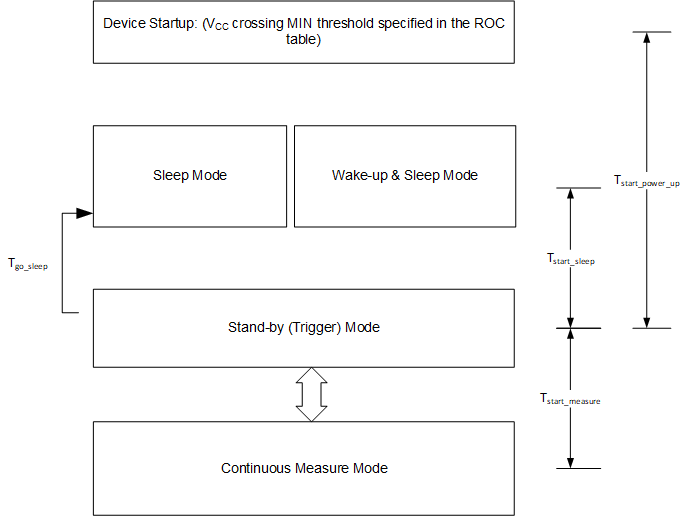ZHCSQY7 september 2022 TMAG5173-Q1
ADVANCE INFORMATION
- 1
- 1 特性
- 2 应用
- 3 说明
- 4 Revision History
- 5 Pin Configuration and Functions
-
6 Specifications
- 6.1 Absolute Maximum Ratings
- 6.2 ESD Ratings
- 6.3 Recommended Operating Conditions
- 6.4 Thermal Information
- 6.5 Electrical Characteristics
- 6.6 Temperature Sensor
- 6.7 Magnetic Characteristics For A1
- 6.8 Magnetic Characteristics For A2
- 6.9 Magnetic Temp Compensation Characteristics
- 6.10 I2C Interface Timing
- 6.11 Power up Timing
- 6.12 Typical Characteristics
- 7 详细说明
-
8 Application and Implementation
- 8.1 Application Information
- 8.2 Typical Applications
- 8.3 What to Do and What Not to Do
- 8.4 Power Supply Recommendations
- 8.5 Layout
- 9 Device and Documentation Support
- 10机械、封装和可订购信息
7.4.4 Continuous Measure Mode
In this mode the TMAG5173-Q1 continuously measures the sensor data per SENSOR_CONFIG & DEVICE_CONFIG register settings. In this mode the result registers can be accessed through the I2C lines. The time it takes for the device to go from standby mode to continuous measure mode is denoted by Tstart_measure.
 Figure 7-6 TMAG5173-Q1 Power-Up Sequence
Figure 7-6 TMAG5173-Q1 Power-Up SequenceTable 7-5 shows different device operational modes of the TMAG5173-Q1.
Table 7-5 Operating Modes
| OPERATING MODE | DEVICE FUNCTION | ACCESS TO USER REGISTERS | RETAIN USER CONFIGURATION | COMMENT |
|---|---|---|---|---|
| Continuous Measure Mode | Continuously measuring x, y, z axis, or temperature data | Yes | Yes | |
| Standby Mode | Device is ready to accept I2C commands and start active conversion | Yes | Yes | |
| Wake-up and Sleep Mode | Wakes up at a certain interval to measure the x, y, z axis, or temperature data | No | Yes | 1, 5, 10, 15, 20, 30, 50, 100, 500, 1000, 2000, 5000, & 20000-ms intervals supported. |
| Sleep Mode | Device retains key configuration settings, but doesn't retain the measurement data | No | Yes | Sleep mode can be utilized by a primary device to implement other power saving intervals not supported by wake-up and sleep mode. |